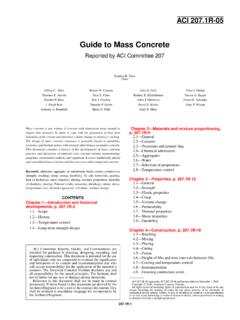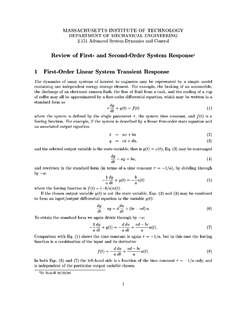Transcription of HEATING, COOLING, LIGHTING - Healthcare Architecture
1 HEATING, cooling , LIGHTING . FOURTH EDITION. HEATING, cooling , LIGHTING . Sustainable Design Methods for Architects Norbert Lechner Cover photograph: Durango Library courtesy of Norbert Lechner Cover design: C. Wallace This book is printed on acid-free paper. Copyright 2015 by John Wiley & Sons, Inc. All rights reserved. Published by John Wiley & Sons, Inc., Hoboken, New Jersey. Published simultaneously in Canada. No part of this publication may be reproduced, stored in a retrieval system , or transmitted in any form or by any means, electronic, mechanical, photocopying, recording, scanning, or otherwise, except as permitted under Section 107 or 108 of the 1976 United States Copyright Act, without either the prior written permission of the Publisher, or authorization through payment of the appropriate per-copy fee to the Copyright Clearance Center, 222 Rosewood Drive, Danvers, MA 01923, (978) 750-8400, fax (978) 646-8600, or on the web at www.
2 Requests to the Publisher for permission should be addressed to the Permissions Department, John Wiley & Sons, Inc., 111 River Street, Hoboken, NJ 07030, (201) 748-6011, fax (201) 748-6008, or online at Limit of Liability/Disclaimer of Warranty: While the publisher and author have used their best efforts in preparing this book, they make no representations or warranties with the respect to the accuracy or completeness of the contents of this book and specifically disclaim any implied warranties of merchantability or fitness for a particular purpose. No warranty may be created or extended by sales representatives or written sales materials. The advice and strategies contained herein may not be suitable for your situation. You should consult with a professional where appropriate. Neither the publisher nor the author shall be liable for damages arising herefrom.
3 For general information about our other products and services, please contact our Customer Care Department within the United States at (800) 762-2974, outside the United States at (317) 572-3993 or fax (317) 572-4002. Wiley publishes in a variety of print and electronic formats and by print-on-demand. Some material included with standard print versions of this book may not be included in e-books or in print-on-demand. If this book refers to media such as a CD or DVD that is not included in the version you purchased, you may download this material at For more information about Wiley products, visit Library of Congress Cataloging-in-Publication Data: Lechner, Norbert, author. Heating, cooling , LIGHTING : sustainable design methods for architects/Norbert Lechner. Fourth Edition. pages cm Includes index. ISBN 978-1-118-58242-8 (cloth)--ISBN 978-1-118-82172-5 (pdf) ISBN 978-1-118-84945-3 (epub).
4 1. Heating. 2.. Air conditioning. 3. LIGHTING . 4.. Sustainable buildings Design and construction. I. Title. 2014. 697 dc23. 2013042723. Printed in the United States of America 10 9 8 7 6 5 4 3 2 1. CONTENTS. FOREWORD TO THE FOURTH EDITION xi The Amoeba Analogy 28. Edward Mazria Supply versus Efficiency 29. Sustainable-Design Issues 30. FOREWORD TO THE FIRST EDITION xiii Climate Change 30. James Marston Fitch The Global Greenhouse 33. The Ozone Hole 33. PREFACE xv Efficiency versus Renewable Energy 34. Energy Sources 34. ACKNOWLEDGMENTS xvii Energy Use in Ancient Greece 34. Nonrenewable Energy Sources 35. 1 HEATING, cooling , AND LIGHTING AS Renewable Energy Sources 38. Hydrogen 44. Conclusion 45. FORM-GIVERS IN Architecture 1 Key Ideas of Chapter 2 46. Introduction 2. Indigenous and Vernacular Architecture 3 3 BASIC PRINCIPLES.
5 Formal Architecture 5 49. The Architectural Approach to Sustainable Design 8. Introduction 50. Dynamic versus Static Buildings 11. Heat 50. Resilient Design 12. Sensible Heat 50. Biophilic Design 12. Latent Heat 51. Color and Ornamentation 12. Evaporative cooling 51. Energy and Architecture 13. Convection 52. Climate and Architecture 14. Transport 52. Sustainability Codes and Voluntary Energy-Transfer Mediums 53. Programs 16. Radiation 53. Integrated Design 17. Greenhouse Effect 54. Decision Making 18. Equilibrium Temperature of a Surface 55. Conclusion 19. Mean Radiant Temperature 56. Key Ideas of Chapter 1 19. Heat Flow 56. 2 SUSTAINABLE DESIGN AND ENERGY SOURCES Heat Sink 57. Heat Capacity 57. 21 Thermal Resistance 58. Heat-Flow Coefficient 58. Easter Island: Learning from the Past 22 Time Lag 58. Sustainable Design 22 insulating Effect of mass 59.
6 Reuse, Recycle, and Regenerate by Energy Conversion 59. Design 24 Combined Heat and Power 60. The Sustainability Movement 26 Fuel Cells 60. Population and Affluence 26 Embodied Energy 61. Growth 27 Conclusion 61. Exponential Growth 27 Key Ideas of Chapter 3 62. v vi CONTENTS. 4 THERMAL COMFORT Solar Time 146. Horizontal Sun-Path Diagrams 146. 63 Vertical Sun-Path Diagrams 148. Drawing Sunbeams 150. Biological Machine 64 Sun-Path Models 153. Thermal Barriers 65 Solar Heat Gain 154. Metabolic Rate 67 Solar Site-Evaluation Tools 158. Thermal Conditions of the Environment 67 Heliodons 159. The Psychrometric Chart 68 Sundials for Model Testing 160. Dew Point and Wet-Bulb Temperatures 69 Conceptually Clear Heliodons 161. Heat Content of Air 70 Conclusion 162. Thermal Comfort 72 Key Ideas of Chapter 6 164. 7 PASSIVE SOLAR.
7 Shifting of the Comfort Zone 73. Adaptive Comfort 74. Clothing and Comfort 75 165. Strategies 75. Conclusion 76 History 166. Key Ideas of Chapter 4 76 Solar in America 166. 5 CLIMATE. Solar Hemicycle 167. Latest Rediscovery of Passive Solar 169. 79 Passive Solar 169. Direct-Gain Systems 171. Design Guidelines for Direct-Gain Introduction 80. Systems 173. Climate 80. Example 175. Microclimate 83. Trombe Wall Systems 175. Climatic Anomalies 85. Design Guidelines for Trombe Climate Regions of the United States and Wall Systems 179. Canada 86. Example 179. Explanations of the Climatic Sunspaces 180. Data Tables 87. Balcomb House 182. Relative Heating and cooling Loads 93. Sunspace Design Guidelines 183. Additional Climate Information 94. Comparison of the Three Main Passive Climate Information for Other Heating Systems 184.
8 Countries 95. General Considerations For Data Tables for Climate Regions, United Passive Solar Systems 184. States 96. Heat-Storage Materials 189. Design Strategies 130. Other Passive Heating Systems 191. Key Ideas of Chapter 5 137. Maximizing Passive Solar 194. 6 SOLAR GEOMETRY Conclusion 194. Key Ideas of Chapter 7 195. 139. 8 PHOTOVOLTAICS AND ACTIVE SOLAR. Introduction 140 197. The Sun 140. Elliptical Orbit 140 Introduction 198. Tilt of the Earth's Axis 141 The Almost Ideal Energy Source 198. Consequences of the Altitude Angle 142 History of PV 199. Winter 144 The PV Cell 201. The Sun Revolves Around the Earth! 144 Types of PV Systems 202. The Sky Dome 144 Balance of system Equipment 203. Determining Altitude and Azimuth Building-Integrated Photovoltaics 203. Angles 145 Orientation and Tilt 205. CONTENTS vii Roofs Clad with PV 206 Roof and Wall Reflectivity 278.
9 Facades Clad with PV 207 Conclusion 281. Glazing and PV 209 Key Ideas of Chapter 9 283. PV Shading Devices 210. PV: Part of the Second Tier 210. Sizing a PV system 210. Finding the PV Array Size for a Stand- 10. PASSIVE cooling 285. Alone Building by the Short Calculation Method 211. Design Guidelines 213 Introduction to cooling 286. The Promise of PV 213 Historical and Indigenous Use of Passive The Cost-Effectiveness of PV and Active Solar cooling 286. Applications 214 Passive cooling Systems 292. Active Solar Swimming-Pool Heating 216 Comfort Ventilation versus Night-Flush Solar Hot-Water Systems 217 cooling 293. Solar Hot-Air Collectors 219 Basic Principles of Airflow 293. Designing an Active Solar system 221 Airflow through Buildings 297. Active/Passive Solar Systems 223 Example of Ventilation Design 306.
10 Preheating of Ventilation Air 224 Comfort Ventilation 307. The Future of Active Solar 226 Night-Flush cooling 309. Conclusion 226 Double-Skin Facades and Operable Key Ideas of Chapter 8 228 Roofs 312. Radiant cooling 313. Evaporative cooling 316. 9 SHADING AND LIGHT COLORS Cool Towers 319. Earth cooling 320. 229 Dehumidification with a Desiccant 322. History of Shading 230 Solar Chimney 323. Shading 234 Conclusion 324. Fixed Exterior Shading Devices 236 Key Ideas of Chapter 10 324. Movable Shading Devices 239. Shading Periods of the Year 246. Overhangs 249. Design of Horizontal Overhangs Basic 11. Method 250 SITE DESIGN, COMMUNITY PLANNING, Shading Design for South Windows 251 AND LANDSCAPING 325. Design Guidelines for Fixed South Overhangs 251 Introduction 326. Design Guidelines for Movable South Site Selection 328.


